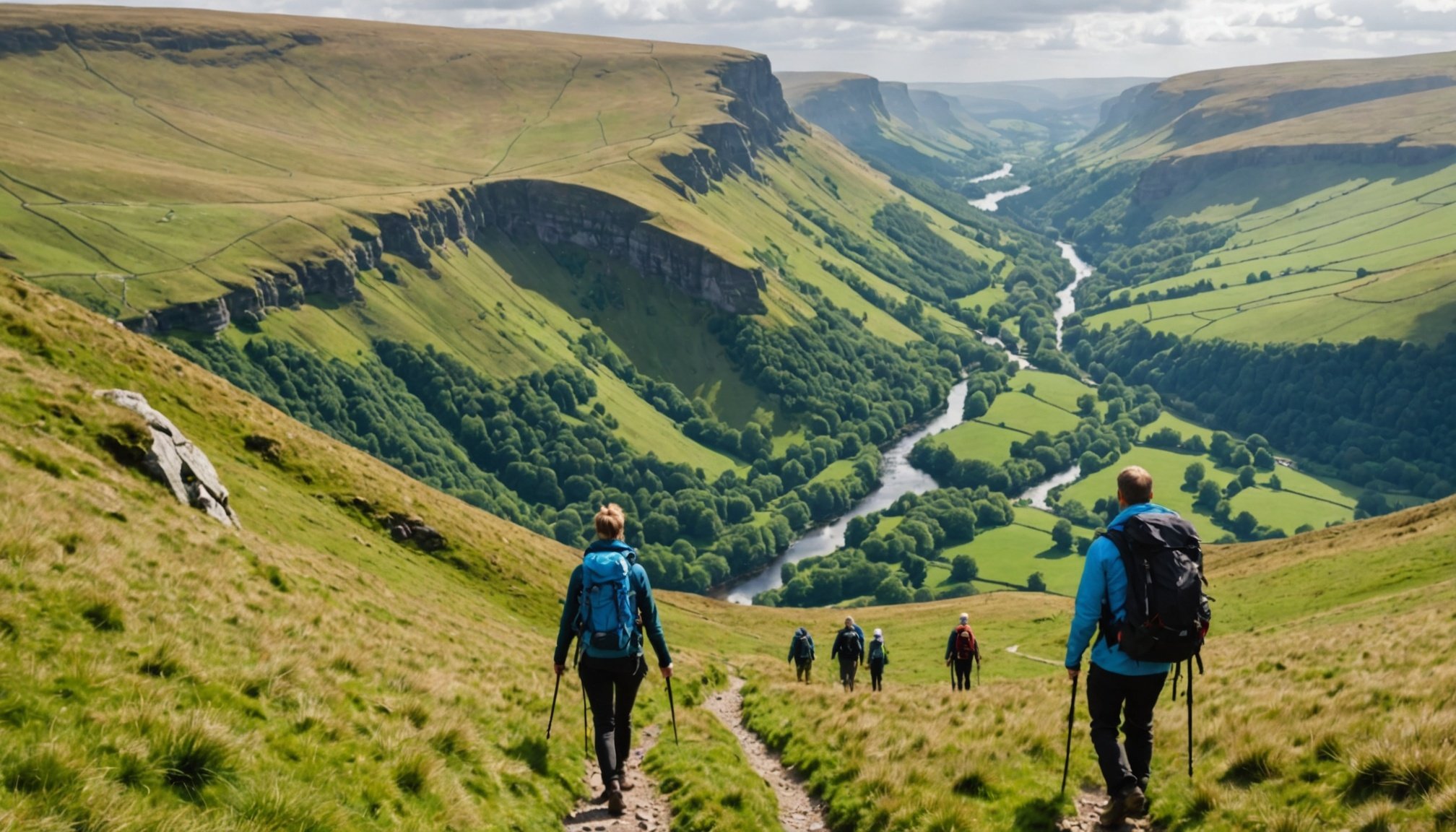Introduction to Sustainable Hiking
Sustainable hiking is an eco-friendly approach to exploring natural landscapes, ensuring minimal harm to the environment. It encompasses practices that leave trails as untouched as possible, conserving the beauty and biodiversity for future generations.
The Peak District is a prime example of a destination that benefits from sustainable hiking practices. This region, with its rolling hills and picturesque views, attracts thousands of outdoor enthusiasts each year. However, with such popularity also comes the responsibility to preserve its natural splendour.
This might interest you : Discover Dorset”s Most Breathtaking Coastal Walks: A Guide to Stunning Views
To achieve sustainable hiking, it is crucial to follow eco-friendly hiking tips that help in reducing one’s environmental footprint. These practices might include sticking to marked trails to avoid disturbing wildlife habitats, carrying reusable water bottles to limit plastic waste, and respecting all local ecosystems by not taking away natural souvenirs.
By adhering to these principles, hikers can significantly minimise the environmental impact of their adventures. This not only protects the natural world but enriches the hiking experience itself, as pristine landscapes make the journey truly remarkable.
This might interest you : Unlocking the Magic: Your Ultimate Guide to the Enchanting West End Theatre in London
Ultimately, sustainable hiking encourages a symbiotic relationship with nature, promoting an ethos of environmental stewardship that echoes far beyond the trails.
Essential Gear for Sustainable Hiking
Embracing eco-friendly hiking gear can significantly reduce your environmental footprint. Opt for clothing and footwear made from sustainable materials like organic cotton, recycled polyester, or hemp. These fabrics not only minimise environmental impact but also offer durability and comfort, essential for an enjoyable hike.
When it comes to hiking essentials, think about the importance of reusable items. Carry a stainless steel or BPA-free water bottle to avoid single-use plastics, and replace disposable utensils with a reusable set made from sustainable materials like bamboo or stainless steel. It’s small changes like these that help preserve the natural beauty of the trails.
Selecting sustainable outdoor equipment brands can be daunting, but it’s worth the extra effort. Look for companies that prioritise ethical manufacturing practices, use recycled materials, and have transparent supply chains. Many brands are now committed to sustainability; some even offer gear with a lifetime guarantee.
Remember, the journey to sustainability on the trails is ongoing. Every eco-conscious choice contributes to a healthier planet and sets a positive example for fellow adventurers. Prioritising quality over quantity in your gear is not only beneficial for the environment but also ensures a superior hiking experience.
Leave-No-Trace Principles
In today’s world, practicing Leave-No-Trace guidelines is more crucial than ever for preserving natural environments. By adhering to these outdoor ethics, we ensure our beloved trails and parks remain pristine for future generations.
Overview of the Seven Leave-No-Trace Principles
The seven Leave-No-Trace principles serve as a framework for minimizing our environmental impact on outdoor spaces. These principles include planning ahead, traveling on durable surfaces, disposing of waste properly, leaving what you find, minimizing campfire impact, respecting wildlife, and being considerate of others. Each principle plays a vital role in maintaining the balance and health of our ecosystems.
Practical Tips for Applying These Principles
When hitting the trail, always plan ahead by researching the area and weather conditions. This prevents unnecessary disturbances to wildlife and vegetation. Stay on marked paths to protect fragile landscapes, and pack out all your waste, including biodegradable items. If you find intriguing natural objects, ensure to leave them unaltered to preserve the environment for fellow explorers.
Consequences of Not Adhering
Ignoring these principles can lead to polluted landscapes, disturbed wildlife, and degraded nature scenes. Without caution, our actions can have irrelevant yet irreversible effects, disrupting ecosystems and diminishing the outdoor experience for all. Practicing responsible outdoor ethics is a shared duty that benefits everyone who cherishes nature.
Best Hiking Trails in the Peak District
Exploring the Peak District offers a blend of breathtaking landscapes and thoughtfully curated hiking trails. Prioritising sustainable routes, several paths stand out for their commitment to preserving the area’s natural beauty while providing memorable hiking experiences.
One such trail is the Pennine Way, a renowned option respected not only for its scenic views but also for the sustainable practices observed along the route. Maintainers work diligently to ensure the path remains accessible without compromising the ecosystem. Similarly, the Limestone Way offers hikers the chance to witness the stunning exposure of limestone across the district, all while minimising environmental impact through proper trail marking and limited interference.
Maintaining trail conditions and ecosystems is crucial for sustainability. Whether dealing with path erosion or wildlife habitats, initiatives focus on responsible usage and maintenance. Trail accessibility varies, with some routes offering improved access points that accommodate a diverse group of hikers, including those requiring specific needs.
Preservation efforts in the Peak District are robust. Trail management teams actively engage in educational programs, fostering a sense of ownership and responsibility among hikers. By respecting path guidelines, visitors contribute to ongoing preservation, ensuring these sustainable routes remain a cherished part of the region’s heritage.
Considerations for Local Wildlife
Exploring nature is an exhilarating experience, but it’s crucial to ensure wildlife safety while enjoying the great outdoors. Respecting natural habitats is essential for preserving the delicate balance of various ecosystems. One key guideline for observing wildlife respectfully is to maintain a safe distance. Getting too close may disturb their natural behavior and could lead to dangerous encounters. Always use binoculars or a camera with a zoom lens for a better view.
Staying on marked trails is paramount for the protection of natural habitats. Wandering off the paths can unintentionally harm the environment and disrupt local flora and fauna. Trails are strategically placed to minimise human impact on sensitive areas. Moreover, seasonal wildlife behaviors should be considered when planning your outings. Animals may be more active during certain times of the year, such as breeding or migration periods, necessitating additional caution.
Understanding these behaviors ensures both the safety of visitors and the animals. As stewards of the environment, it’s our responsibility to support wildlife conservation by following these guidelines and advocating for the safety of our natural world. Each small effort contributes significantly to preserving the wonders of nature for future generations.
Eco-Conscious Lodging Options
Embracing sustainable accommodation while exploring the Peak District enhances both your travel experience and environmental impact. Diverse options await eco-minded travellers, from rustic eco-lodges to luxurious green hotels. Many establishments implement energy-efficient practices, such as solar power and water conservation tools, which ensure minimal carbon footprints. These eco-friendly lodging choices often promote local culture by utilising sustainable materials in their construction and offering organic, locally-sourced produce.
Choosing sustainable stays benefits hikers in many ways. Firstly, it’s an opportunity to support businesses that mirror one’s environmental values. This symbiosis between customer and provider fosters a positive, responsible travel ethic. Additionally, staying in eco-friendly lodging often offers unique experiences such as guided wildlife walks or workshops on sustainability practices, enriching the hiking adventure.
To find certified green lodgings, there are several resources available. Websites like Green Tourism and Eco BNB showcase accommodations with verified sustainability credentials. These platforms often provide detailed insights into each lodging’s eco-practices, ensuring an informed decision. Whether you’re new to eco-travel or a seasoned environmentalist, the Peak District offers a spectrum of sustainable accommodation tailored to enrich your hiking journey.
Actionable Steps for Sustainable Hiking
When embarking on a hiking trip, planning is crucial, especially for ensuring minimal environmental impact. Begin by choosing trails that align with your skill level and carry out research on the terrain. Being informed is the first step in adopting sustainable outdoor practices.
Planning a hiking trip involves understanding the trail rules. Familiarize yourself with local regulations regarding waste disposal, fire restrictions, and wildlife interactions to promote safety and sustainability.
To adopt sustainable outdoor practices, pack necessary items only, favoring reusable and eco-friendly products. Reducing your ecological footprint is as important as the hike itself. Water bottles, lightweight solar chargers, and non-toxic sprays are intelligent choices for environmentally conscious hikers.
Insights from experienced hikers reveal the importance of staying on marked paths. Straying from trails can lead to erosion and habitat destruction. Additionally, consider carpooling to the starting point or using eco-friendly transportation when planning a hiking trip.
For further reading, publications like “Leave No Trace” offer comprehensive guides on sustainable hiking. This resource presents step-by-step practices to incorporate into your itineraries, enhancing both your experience and nature preservation. Prioritizing planning and informed choices strengthens your hiking while respecting the environment.
Resources for Further Engagement
Embarking on a journey of sustainable hiking leads to a rewarding experience by immersing yourself in nature while being eco-friendly. There are various websites and organizations dedicated to promoting sustainable hiking practices. These platforms are invaluable as they offer actionable tips and tools, and even support outdoor enthusiasts in making responsible choices.
- Leave No Trace Center for Outdoor Ethics is a renowned organization providing guidelines that educate people on minimizing their environmental footprint while enjoying the outdoors.
To delve deeper into these eco-friendly practices, books and guides specifically focusing on sustainable outdoor activities are available. Titles such as “Leave No Trace: A Guide to the New Wilderness Etiquette” serve as excellent resources, enlightening readers on essential principles of tread lightly.
Furthermore, local initiatives have gained traction, aiming to promote conservation and sustainability practices. For instance, Peak District’s community-led projects involve habitat restoration, providing a perfect opportunity for hikers in the area to contribute towards preserving the natural beauty. Engaging with these initiatives allows hikers to learn and participate in sustaining the environment.
A blend of outdoor education and practical books enhances the hiking experience, ensuring you leave only footprints and take only memories.











